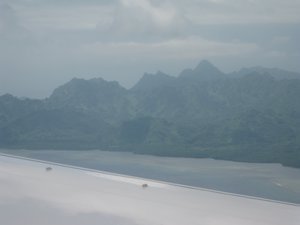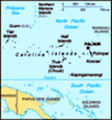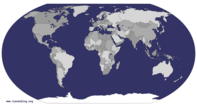Advertisement
Published: July 26th 2009

 Approaching Kosrae coast
Approaching Kosrae coast
On the trusty Continental island hopperKosrae
Got our first glimpse of a tropical island paradise approaching the airport on the nw coast of Kosrae (ko-shry’), the easternmost of the four states of the Federated States of Micronesia (FSM). A car from our lodging, the Kosrae Village Resort, picked us up at the tiny air terminal. The immediate impression of the island is of exuberant plant life - every inch is bursting with greenery, from mosses and ferns to giant trees. Very little traffic on the peripheral road, which nearly circles the island - the only road of any length. The 5,000 or so residents mostly live along this road - there are five settlements or villages where the houses are closer and there are a few little stores, as well as schools or government buildings, but there's no one central town. Wahlung, the village at the far end of the road from the airport, on the west side of the island, is fighting plans to finish paving the road to their village, preferring the isolation they get from being mostly accessible by boat. The island is only 6-8 mi across, but it takes a while to get places because everyone drives slow.
We rode
about halfway around the island, to KVR in the middle of the east side. To visit on Google Earth, the main building here is at N 5 deg, 18.645'; E 163 deg, 2.035'. You can barely see a roof - the whole place is buried in jungle. The roof is the top of the main dining structure, which is apparently the largest building anywhere built using traditional Kosraen techniques. We had one of six huts, about 20 yds back from the narrow beach. Everything here is built with traditional materials and techniques - log structure, walls and roof made of mats woven from pandanus fronds, and all tied together with string. Lights, fans, and real plumbing, but no A/C - with the breeze off the ocean and the high humidity, things were damp at times, but usually comfortable. The windows are screened, but the space between the roof peak and the walls is wide open. This fact (plus the netting hung over the beds, plus a bit of a slam in divers' newsletter
Undercurrent) made me fear the worst - thick clouds of mosquitoes which would drive me nuts. Anyhow, for whatever reason (can they drown?), we seldom saw mozzies
during our 9-day stay and ended up with just a few bites - so since there’s no malaria or dengue on the island, the buggers were a total non-issue.
No sooner did we arrive at KVR than we were invited to watch a meal being prepared using traditional Kosraen foods and cooking techniques. With incredible luck, we had arrived just as a crew was there to video scenes for a Continental Micronesia promotional campaign. The cooking demo was organized by Madison Nena, who's well-known on the island for his efforts to preserve Kosrae's culture and ecology. When the meal was ready, there was lots more food than the crew could eat, so obviously someone had to help out 😊. The breadfruit soup, grilled tuna, and mangrove crab would have been feast enough, but we also had the rare treat of sampling
fafa, a dessert consisting of little gray balls of a doughy substance made by pounding taro, covered with a special caramel-y syrup - delectable!
Fafa is apparently only made for special occasions, and then only by members of a few families who hand down the craft.
We can't praise Bruce and Katrina who run KVR highly enough

 At sunset from beach 20 yds in front of our hut
At sunset from beach 20 yds in front of our hut
The reef flats out to the breakers are a maze of tidepools at low tide- their deep knowledge of every aspect of diving, plus their incredible concept and hard work that resulted in KVR, make them unique in our travel experience. It was worth the trip for this stop alone, and we ended up staying a couple extra days to savor the KVR ambiance. Not what you’d want for a business trip, but to experience the real Micronesia, you couldn’t do better.
Weather ran the gamut for Kosrae, from a couple absolutely torrential all-night downpours to mostly sunny days, with a few passing showers thrown in for good measure. At least they don’t get cyclones here - that’s more to the west (where we’re headed.) Temps stay in the low-to-mid 80’s, a few degrees up or down. Humidity feels usually like about 80-85%, but reaches 100% at times causing beads of moisture to form on everything. (I’m no fan of muggy, but it’s a lot easier to take here than in DC.)
We spent most of our daytime hours diving, the main reason for our circuitous route to NZ - five days of two-tank dives with divemaster Ben and captain Gordon, in KVR’s little outboard catamaran. There’s no surrounding lagoon here, so

 Dining lodge at KVR
Dining lodge at KVR
Excellent food and service - good thing 'cause there's not a lot to pick fromall diving is on the reef dropoff a short distance offshore. We lucked out on two days' runs out to the dive areas, when we were picked up by groups of show-off dolphins - they seemed to be competing to see which could stay in front the longest. Minutes passed with these powerful critters cruising a couple feet below the bow, easily pacing the boat, and occasionally leaping clear of the water a few yards away.
We’re new to the Pacific, so we're easily awed, but the hard corals for which Kosrae is famous defy description. Partly because of no typhoons, and partly because they’ve used mooring buoys here for a couple decades, the coral is immense and pristine. There are large circular “tabletops” 8 ft across and just a few inches thick, and fantastic swirls of green coral sheets that are 3 ft deep and as thin as cardboard. We saw coral that was a beautiful blue, and some that resembled a bed of nails.
The fish life was, I suppose, mundane by Pacific standards, but we’d consider a whole week in Bonaire (about the best diving in the Caribbean before Hurricane Omar) a hit if we
saw in total what we see on each dive here. Individual anemones 2-3’ across are common. Each harbors its clan of anemonefish, sometimes the delicate pink ones that hover close to home, and sometimes the boldly-striped 6” orange-fins that swim out to challenge the intruder. When an anemone closes up, to digest something or just because “it’s cold”, it becomes a beachball-sized shiny indigo blue, pink or emerald green ball with a few tentacles peeking out. Its fish mill about, out of sorts, waiting for home to open back up.
On most dives, the coral wall drops off to unseen depths - often the deep side is a featureless blue, but occasionally a shark or turtle materializes from the void. Usually we’d see only a single shark at a time, mostly young black- or white-tip reef sharks about 3’ long. They’re so fast and the sight is so mesmerizing that I (being a newbie at underwater photography) never got a shot of one. A few came pretty close, a few yards away, lithe and unscarred, just looking us over - they reminded us of teenagers, arrogance mixed with uncertainty. We said a prayer that these little beauties wouldn't end
up flopping around in an agonizing demise with their fins hacked off to make soup for some wretched exhibitionist "gourmet". One day three gray reef sharks cruised by less than 20 yds away - one was nearly 6’ long, the biggest we saw here. Another time, two beautiful spotted eagle rays made a couple circles around us in perfect formation, like a pair of fighter planes. Then one of them hung around for a full three-minute photo op.
Sunday, the entire island closes down - stores, diving, everything - and most of the population attends (mostly Congregationalist) church. We attended a service and were impressed by the
a capella singing of the large choir, which kind of made it worth sitting through the whole (Kosraen language) service. Then we spent the afternoon walking the nearly deserted road and enjoying the peaceful ambience, except while fending off the territorial dogs by shaking a stick at them. (The whole stick thing was great practice for Vera, who brandished one on her morning runs until the dogs gave up and accepted her.)
The island has a couple sets of ruins which we toured. The Lelu ruins are big, old (first part
complete in 1400), and intact or restored enough to give you a pretty good idea of their impressive scale. They’re virtually in the backyards of the dense Lelu settlement, so there’s a little trash lying about that somewhat detracts from their feel, tho thankfully no graffiti. The other set is the Menka ruins, which are an hour’s hike along a river into the interior - in fact, the ruins site is pretty much dead center of the island. I expected a muggy, mosquito-infested hike through the dense jungle, but this was anything but. As soon as we left the coast, the air lightened and cooled, and the heavy shade made the entire hike delightful. There were literally no mosquitoes on the entire hike, none - we never even used repellent. These ruins are as time has left them, and they’re supposedly much older than Lelu. The walls are mostly tumbled down, so you’re looking at the outlines of where the buildings stood, the wood structures long since rotted away. There's been little exploration of this ruin, which encompasses over 100 building sites, but our guide thought a European team will begin excavations shortly. Anyhow, the site is nearly pristine, buried
in deep jungle which is worth a visit on its own account - I highly recommend this hike.
And while we’re on to recommendations, we loved our tour of the mangroves in the Utwa-Wahlung Conservation Area with guide Tatau (who brought his wife along to bail.) There’s a series of channels through mangrove areas along the southwest coast, and Tatau takes you through them with incredible skill in his outboard-equipped outrigger dugout canoe. (The terminally fit and adventurous can do this one by kayak, but you need to cover a lot of ground without getting lost, and racing over the smooth water at 15 knots in a canoe is a hoot in itself.) If the timing works out between the time and tides, you can end the tour by watching the resident colony of fruit bats set out for their nightly pillaging of the locals’ fruit trees (including Tatau’s.)
Finally, a few random recollections: Seeing very few other tourists or divers on the island, which was pretty sweet and also a little weird. While Kosrae was never a tourist hotspot, apparently what tourism there was never really recovered after the Asian economic slowdown and 9/11, and
you could see that several businesses and hotels have gone belly-up. Having this incredible gem of an island practically all to ourselves (tourist-wise) made us feel like royalty! We met folks who want to drop "traditional" customs like no Sunday commercial activities, or even have a mega-resort go up, to revitalize tourism, but we hope it doesn't happen to Kosrae.
Noticing a gang of laborers hard at work building the new high school at 6:00 PM, a level of industriousness hitherto unnoted on Kosrae - only to learn that the school is being built by a Chinese company using exclusively Chinese workers imported for the job.
Admiring the flash new SUV, one of the nicer vehicles on the island, with US Peace Corps insignia on the door - great to see my tax dollars hard at work.
Crab-watching - if you enjoy watching crabs run around, this is the place. The whole KVR property is riddled with holes every few yards, each the home of a coconut crab 4-8” across. They apparently climb the coconut trees near their holes and cut young coconuts off, then cut a big hole through which they chomp the meat. They usually
disappear into their holes the moment you appear, but occasionally one stands his ground and waves his claws at you menacingly before scuttling off. A few even paraded around the open-air dining room one night, to the consternation of the resident cats, when especially heavy rain drove 'em from their burrows. The real biggies hang out in the mangrove swamps, though, and are captured for the table from time to time. We saw a few of these that went at least 3 pounds each (and yes, they are indeed delicious.)
And finally, we noticed that although most local families probably hardly have a bank account, almost every family lives in their own house on their own land, which usually includes a beautiful oceanfront view. The houses and yards are generally well cared-for, despite the overwhelming tendency of things manmade to rust and rot in the eternal salt-air humidity. The kids are always hard at play and seem uniformly and constantly happy, and the adults are among the friendliest and happiest-seeming we’ve encountered in our travels. (As we’re occasionally reminded, there may be more to this happiness thing than one’s 401K balance or house value.) Families seemed a bit large
for sustainability - the reefs are nearly devoid of larger fish due, probably, to intensive subsistence fishing - but they were happy hanging out together. There’s a growing tendency for the younger generation here to head for the bright lights - lots of young Kosraens join the US military to get a foothold in the States - but we met plenty of folks who seem to appreciate the values and customs that have been handed down. Hopefully Kosrae will remain one of those rare idyllic places that isn’t pretty much like every other place. It’s a big world and we’ve got a lot to see, but we really hope we have the time and opportunity to return to Kosrae.
Advertisement
Tot: 0.113s; Tpl: 0.015s; cc: 5; qc: 53; dbt: 0.0536s; 1; m:domysql w:travelblog (10.17.0.13); sld: 1;
; mem: 1.1mb




















